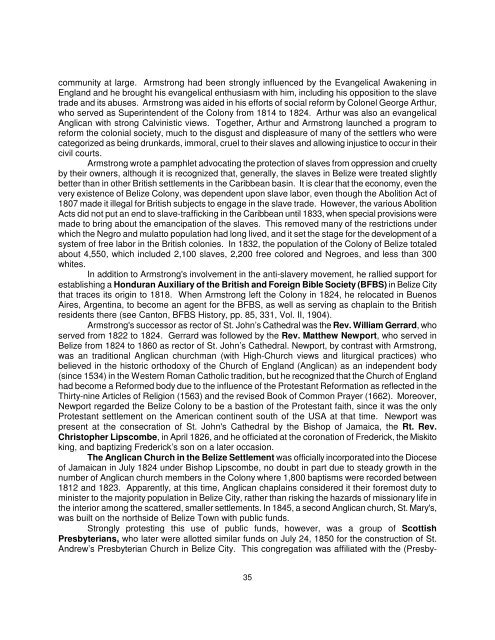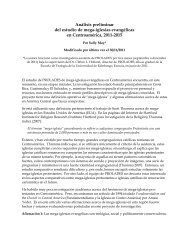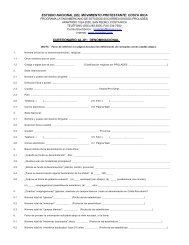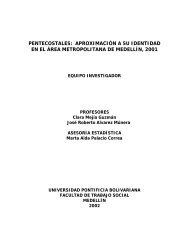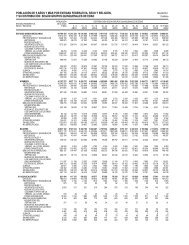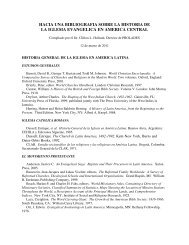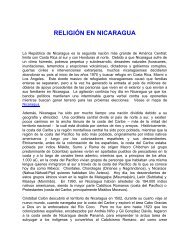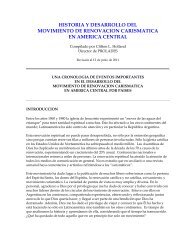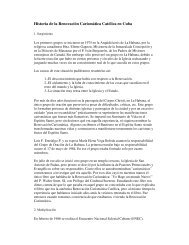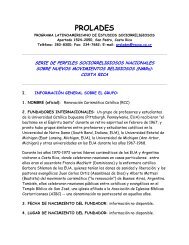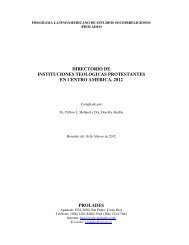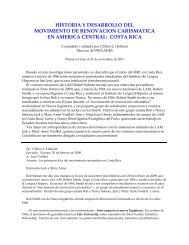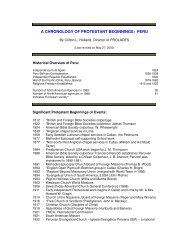belize, 1980 - Prolades.com
belize, 1980 - Prolades.com
belize, 1980 - Prolades.com
Create successful ePaper yourself
Turn your PDF publications into a flip-book with our unique Google optimized e-Paper software.
<strong>com</strong>munity at large. Armstrong had been strongly influenced by the Evangelical Awakening in<br />
England and he brought his evangelical enthusiasm with him, including his opposition to the slave<br />
trade and its abuses. Armstrong was aided in his efforts of social reform by Colonel George Arthur,<br />
who served as Superintendent of the Colony from 1814 to 1824. Arthur was also an evangelical<br />
Anglican with strong Calvinistic views. Together, Arthur and Armstrong launched a program to<br />
reform the colonial society, much to the disgust and displeasure of many of the settlers who were<br />
categorized as being drunkards, immoral, cruel to their slaves and allowing injustice to occur in their<br />
civil courts.<br />
Armstrong wrote a pamphlet advocating the protection of slaves from oppression and cruelty<br />
by their owners, although it is recognized that, generally, the slaves in Belize were treated slightly<br />
better than in other British settlements in the Caribbean basin. It is clear that the economy, even the<br />
very existence of Belize Colony, was dependent upon slave labor, even though the Abolition Act of<br />
1807 made it illegal for British subjects to engage in the slave trade. However, the various Abolition<br />
Acts did not put an end to slave-trafficking in the Caribbean until 1833, when special provisions were<br />
made to bring about the emancipation of the slaves. This removed many of the restrictions under<br />
which the Negro and mulatto population had long lived, and it set the stage for the development of a<br />
system of free labor in the British colonies. In 1832, the population of the Colony of Belize totaled<br />
about 4,550, which included 2,100 slaves, 2,200 free colored and Negroes, and less than 300<br />
whites.<br />
In addition to Armstrong's involvement in the anti-slavery movement, he rallied support for<br />
establishing a Honduran Auxiliary of the British and Foreign Bible Society (BFBS) in Belize City<br />
that traces its origin to 1818. When Armstrong left the Colony in 1824, he relocated in Buenos<br />
Aires, Argentina, to be<strong>com</strong>e an agent for the BFBS, as well as serving as chaplain to the British<br />
residents there (see Canton, BFBS History, pp. 85, 331, Vol. II, 1904).<br />
Armstrong's successor as rector of St. John’s Cathedral was the Rev. William Gerrard, who<br />
served from 1822 to 1824. Gerrard was followed by the Rev. Matthew Newport, who served in<br />
Belize from 1824 to 1860 as rector of St. John’s Cathedral. Newport, by contrast with Armstrong,<br />
was an traditional Anglican churchman (with High-Church views and liturgical practices) who<br />
believed in the historic orthodoxy of the Church of England (Anglican) as an independent body<br />
(since 1534) in the Western Roman Catholic tradition, but he recognized that the Church of England<br />
had be<strong>com</strong>e a Reformed body due to the influence of the Protestant Reformation as reflected in the<br />
Thirty-nine Articles of Religion (1563) and the revised Book of Common Prayer (1662). Moreover,<br />
Newport regarded the Belize Colony to be a bastion of the Protestant faith, since it was the only<br />
Protestant settlement on the American continent south of the USA at that time. Newport was<br />
present at the consecration of St. John's Cathedral by the Bishop of Jamaica, the Rt. Rev.<br />
Christopher Lips<strong>com</strong>be, in April 1826, and he officiated at the coronation of Frederick, the Miskito<br />
king, and baptizing Frederick’s son on a later occasion.<br />
The Anglican Church in the Belize Settlement was officially incorporated into the Diocese<br />
of Jamaican in July 1824 under Bishop Lips<strong>com</strong>be, no doubt in part due to steady growth in the<br />
number of Anglican church members in the Colony where 1,800 baptisms were recorded between<br />
1812 and 1823. Apparently, at this time, Anglican chaplains considered it their foremost duty to<br />
minister to the majority population in Belize City, rather than risking the hazards of missionary life in<br />
the interior among the scattered, smaller settlements. In 1845, a second Anglican church, St. Mary's,<br />
was built on the northside of Belize Town with public funds.<br />
Strongly protesting this use of public funds, however, was a group of Scottish<br />
Presbyterians, who later were allotted similar funds on July 24, 1850 for the construction of St.<br />
Andrew’s Presbyterian Church in Belize City. This congregation was affiliated with the (Presby-<br />
35


